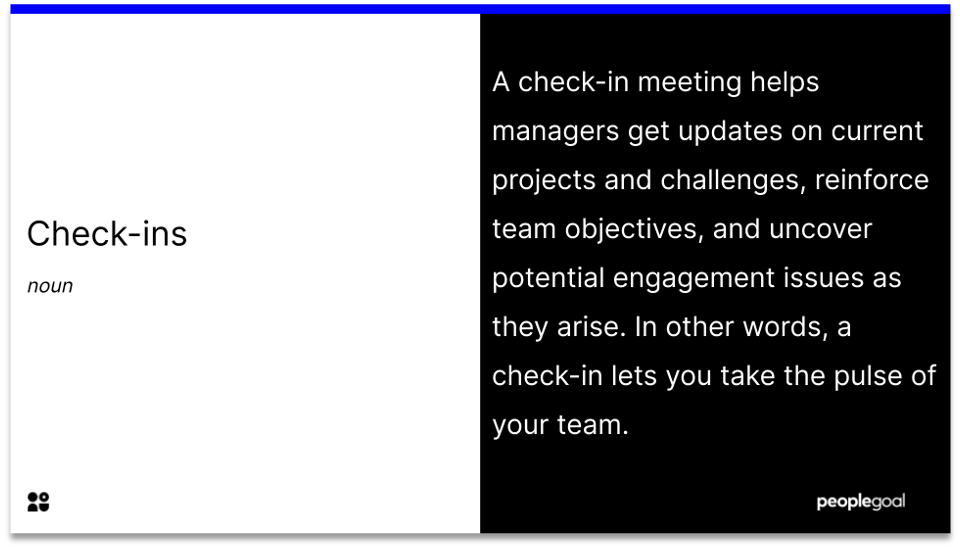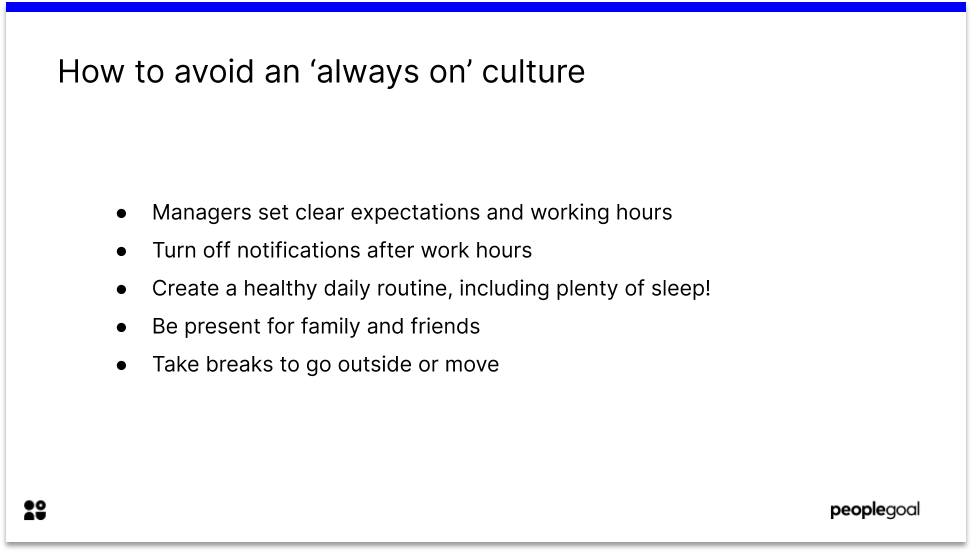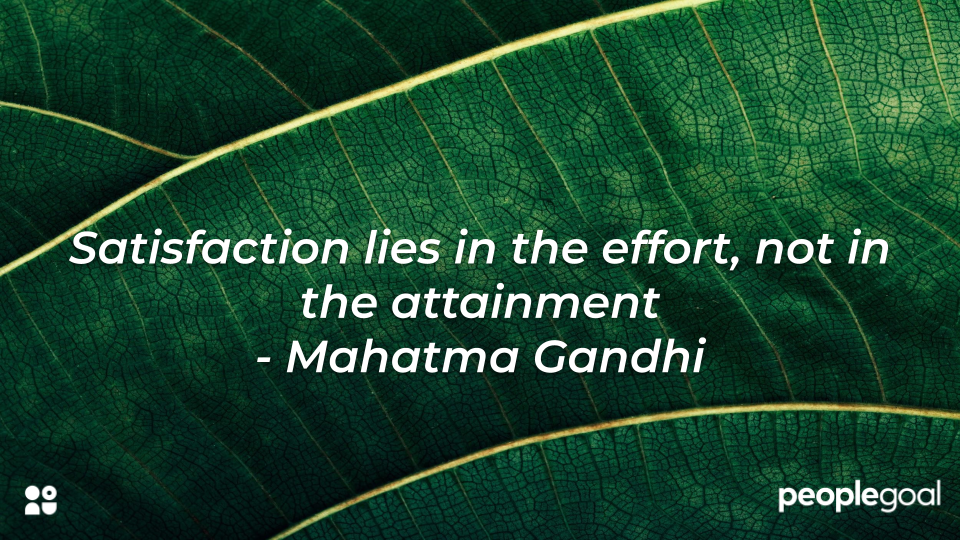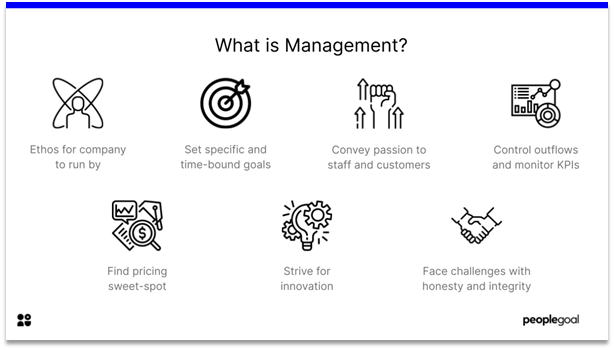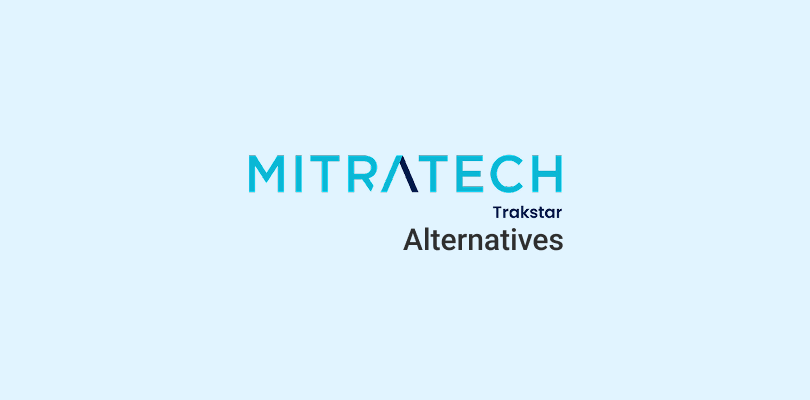If you’re looking for BambooHR alternatives, something isn’t clicking as it should, right?
Maybe you’ve outgrown its workflows. Maybe the extra pricing for every new feature is wearing thin. Or maybe your team simply needs more than basic HR checklists.
Well, I’ve spent years implementing HR systems for companies with 50 to 5,000 employees, and I can tell you that this tipping point is familiar.
In this blog, I’ve curated a list of the best BambooHR alternative tools, with real examples, side-by-side comparisons, and practical insights to help you find the right fit for where you’re headed.
Here’s a sneak peek into these:
| Tool | Best for | Starting Price |
|---|---|---|
| PeopleGoal | Boosting employee performance & improving engagement | FREE 7-day trial. Paid starts at $4/user/month. |
| Lattice | HRIS in large enterprises | Starts at $10/seat/month. |
| 15Five | Enterprise performance review system | Starts at $4/user/month, billed annually. |
| Leapsome | Personalized learning paths | Custom pricing. |
| Rippling | Automating technical HR tasks | Custom pricing. |
| Gusto | Payroll & compliance support | Starts at $49/month + $6/user/month. |
| Zenefits | Administration & compliance support for SMBs | Custom pricing. |
| HiBob (Bob) | Customizing onboarding flows | Custom pricing. |
| ADP Workforce Now | Employee attendance management | Custom pricing. |
| Paylocity | Online payroll solutions | Custom pricing. |
My Top 3 Choices as BambooHR Competitors
If you are looking for some quick information on competitors to BamboorHR, here are my top 3 choices from the list above.
1. PeopleGoal
If you want full control over how performance, feedback, and engagement flow across your company, PeopleGoal delivers. I’ve built everything from DEI-aligned goals to automated check-ins inside it. You’re not stuck with templates; you design your own HR system. It’s ideal when your strategy needs agility, not rigid review cycles.
2. Lattice
You’ll appreciate Lattice if you care about continuous development, not just annual reviews. I’ve helped companies align OKRs, 1:1s, and growth plans without needing five separate tools. You get performance insights, engagement data, and career frameworks—all in one dashboard. It’s built for people-first teams that still need executive-level reporting.
3. 15Five
15Five helps you turn managers into coaches, not just reviewers. I use it for weekly check-ins and Best-Self Reviews because it keeps conversations real and actionable. If you want lightweight performance tools with heavy impact, this is your match. You’ll never be caught off guard at review time again.
11 Best BambooHR Alternatives in 2025
Here’s a detailed look at the top 11 BambooHR alternatives you can explore this year. I’ve broken down each tool by use case, strengths, and how it compares to BambooHR, so you can pick what actually fits your needs.
1. PeopleGoal
Best for Boosting Employee Performance & Improving Engagement
One of my clients, a huge creative agency, was under a rigid annual review system. They needed agility, so we transitioned to PeopleGoal. Within weeks, they were running automated feedback workflows, 30-day check-ins for new hires, and department-specific 360-degree reviews.
I’ve seen organizations build DEI-specific performance goals, link engagement surveys to employee development plans, and even create their own feedback apps inside this platform. PeopleGoal is like LEGO for HR: everything snaps together, and nothing’s locked down. You get total control over HR workflows, OKR software, forms, notifications, and data, all without coding.
If you’ve ever felt like your HR tool is holding your people strategy hostage, this is your get-out-of-jail card. PeopleGoal adapts to your processes, not the other way around. It’s perfect for fast-moving teams that want to evolve how they manage, engage, and grow talent, all in one place.
Why PeopleGoal Is One of the Best BambooHR Alternatives
- The workflow automation engine in PeopleGoal lets you build condition-based employee performance and feedback flows, whereas BambooHR restricts you to static task checklists with no logic or triggers.
- 360-degree feedback and peer reviews are built into PeopleGoal by default, unlike BambooHR, which lacks native support for multi-rater reviews.
- Custom fields and scoring frameworks in PeopleGoal let you align performance with strategic priorities like DEI, while BambooHR’s review forms are limited to preset formats.
- You can run recognition programs, engagement surveys, and onboarding check-ins all in one system, while BambooHR separates these into siloed features with limited depth.
- PeopleGoal integrates easily with Slack and Teams, embedding HR into the flow of daily work. BambooHR’s integration ecosystem is narrower and less focused on collaboration.
- The pricing structure is transparent and scalable for startups and mid-sized teams. On the other hand, BambooHR’s pricing is quote-based and rises with added modules like performance or surveys.
- You can build custom HR apps directly in PeopleGoal, like a custom onboarding tracker or exit interview form, whereas BambooHR doesn’t support this level of modularity or flexibility.
Price: FREE 7-day trial. Paid starts at $4/user/month.
2. Lattice
Best for HRIS in Large Enterprises
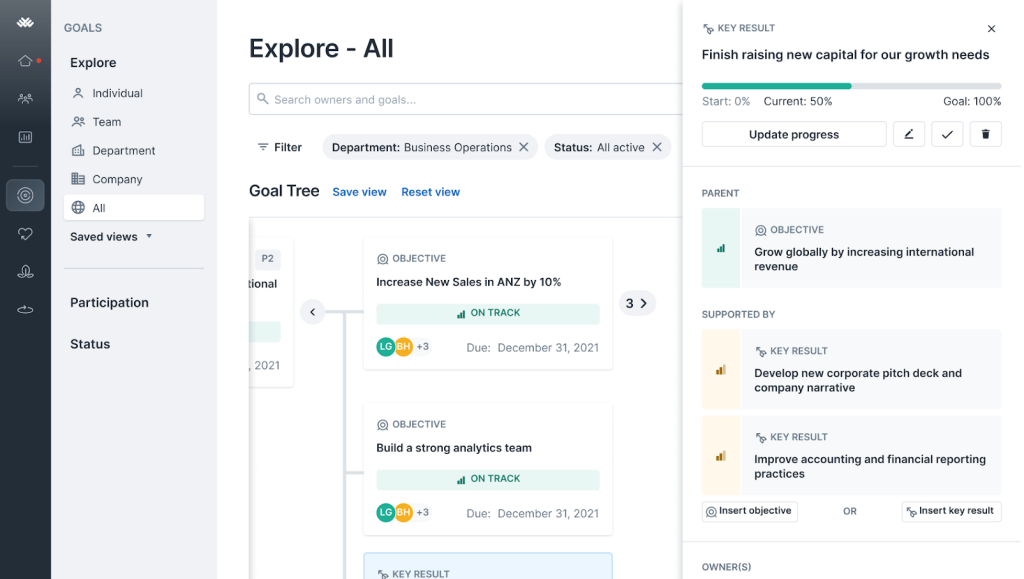
A high-growth SaaS startup I advised grew from 40 to 160 people in a year, and their old HR tool couldn’t scale with them. We deployed Lattice, and suddenly every manager had structured 1:1s, every employee had OKRs tied to company goals, and HR could view performance trends in real time.
I’ve used Lattice—it’s clean, fast, and powerful. One engineering manager told me it was the first time she could connect feedback, career growth, and compensation in one place. That’s what Lattice does best. It builds a feedback culture around development, not just compliance.
From manager toolkits and engagement surveys to growth plans and pulse feedback, everything is interconnected. You don’t need five systems to manage performance anymore. Lattice replaces static reviews with dynamic, continuous conversations, which shows in retention and morale.
Why Lattice Is One of the Best BambooHR Alternatives
- Lattice supports flexible review cadences, including quarterly, monthly, or continuous feedback loops, while BambooHR limits you to periodic cycles with rigid review timelines.
- OKRs can be created, updated, and aligned with team or org-level goals directly within Lattice. In comparison, BambooHR lacks any built-in support for structured OKRs or visual goal tracking.
- Career development tools such as growth paths, competency matrices, and skill tracking are integrated in Lattice, whereas BambooHR has no native feature for career planning.
- Slack and Teams integrations allow recognition, feedback nudges, and reminders to happen in real time in Lattice. BambooHR’s integrations are limited and do not support engagement in daily workflows.
- Engagement surveys in Lattice include sentiment analysis and reporting dashboards that inform action plans. By contrast, BambooHR offers only a basic eNPS survey with minimal data breakdowns.
- Performance review templates in Lattice are fully customizable—from rating scales to question types—while BambooHR restricts you to more generic and limited review structures.
- Lattice connects engagement, performance, and goals into a unified analytics dashboard. BambooHR does not offer this level of interconnected data visualization across features.
Price: Starts at $10/seat/month.
3. 15Five
Best for Enterprise Performance Reviews System

I once worked with a media agency whose team leads only checked in during performance review season. So, I suggested we bring in 15Five, which completely flipped their communication rhythm. Managers began using the weekly check-in tool, and by week three, they were solving problems proactively.
I use 15Five myself for coaching because it builds strong feedback habits through small, consistent actions. Employees update their priorities, flag issues, and receive recognition—all in one place. It feels less like HR software and more like a habit tracker for great management.
One feature I love is the Best-Self Review—it blends performance with personal growth in a way that makes feedback feel supportive, not punitive. If you want to encourage coaching conversations, keep your team aligned, and avoid blindsiding employees at review time, 15Five is your secret weapon.
Why 15Five Is One of the Best BambooHR Alternatives
- Weekly check-ins are central to 15Five’s design and help build a consistent manager-employee feedback loop. BambooHR does not offer any built-in weekly reflection or update mechanism.
- OKRs and individual goals can be tracked directly in 15Five, aligned with larger company goals. In contrast, BambooHR does not provide native goal tracking or OKR visibility.
- The platform enables 360-degree feedback and anonymous peer evaluations during reviews, which are not supported in BambooHR’s standard performance module.
- Coaching tools, such as suggested one-on-one questions and customizable meeting agendas, are included in 15Five, while BambooHR lacks any structured manager coaching support.
- Pulse surveys in 15Five are customizable, frequent, and tied to engagement analytics, unlike BambooHR’s static eNPS survey, which offers no follow-up tools or insights.
- Peer recognition through “High Fives” builds team culture inside the platform, while BambooHR offers no peer-to-peer recognition feature.
- Performance, engagement, and development data are interconnected in 15Five’s dashboard, giving HR full visibility into trends. BambooHR separates these features and does not provide a unified view.
Price: Starts at $4/user/month, billed annually.
4. Leapsome
Best for Personalized Learning Paths
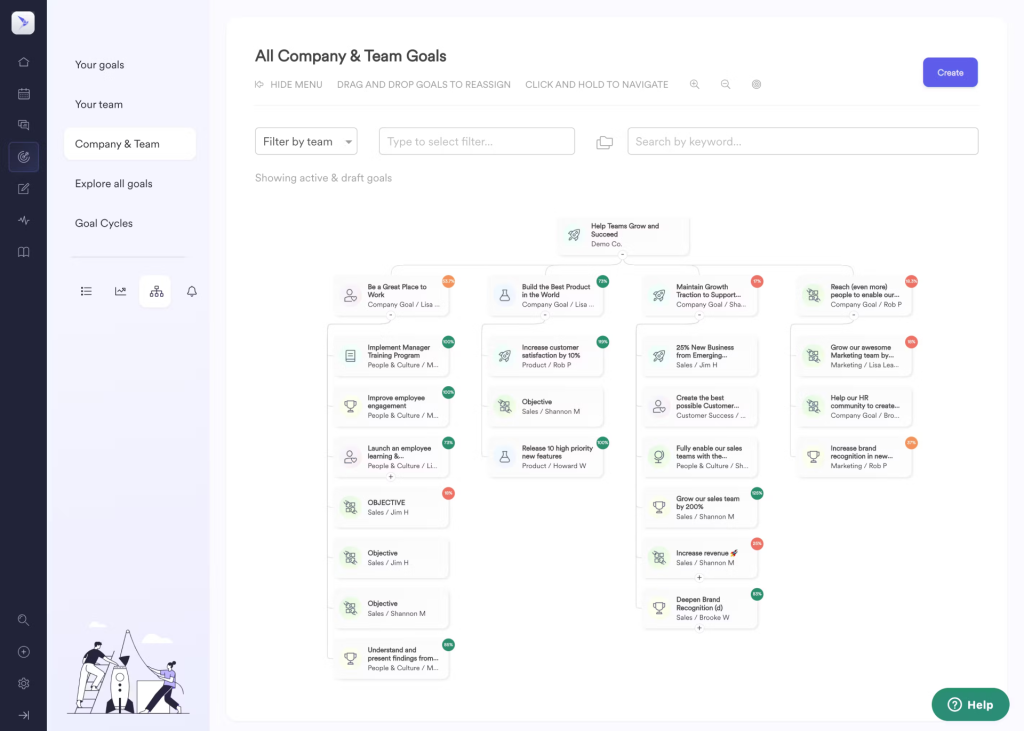
One of the more complex setups I helped clean up was a mid-sized tech company using four different platforms: a learning tool, a survey tool, a goal tracker, and a performance system duct-taped together with exports.
We rolled it all into Leapsome. It was like watching a machine go from manual to autopilot. Leapsome makes it feel natural to transition from a performance review to a learning assignment, or from a goal update to a pulse survey.
I’ve worked with teams who’ve used its AI sentiment analysis to catch cultural issues before they became problems. A marketing lead once said, “We didn’t just adopt a tool—we found a way to actually grow people.”
Leapsome is a rare breed that does performance and development equally well. If your goal is to scale without building an HR Frankenstein, this is your one-dashboard solution.
Why Leapsome Is One of the Best BambooHR Alternatives
- Leapsome includes a fully integrated learning management system (LMS), which allows you to assign courses and track completion directly from performance reviews. BambooHR, on the other hand, does not include any native learning tools or LMS features.
- Performance reviews can trigger personalized learning paths or follow-up development plans, whereas BambooHR offers no integration between reviews and learning workflows.
- Goals and OKRs can be assigned at individual, team, or organizational levels and visualized in real-time. In contrast, BambooHR does not support structured OKR frameworks or visual goal alignment.
- AI-driven sentiment analysis in Leapsome lets you interpret open-text feedback from surveys. BambooHR lacks any AI-based analysis and limits insights to simple numeric trends.
- Engagement surveys in Leapsome are customizable, scheduled, and come with heatmaps and trend analysis. BambooHR only supports eNPS with limited filtering and no dynamic reporting.
- You can build automated workflows between performance, learning, and engagement modules. BambooHR keeps these modules siloed and without cross-functional automation.
- Dashboards in Leapsome combine data from reviews, goals, learning, and surveys into one central analytics view. BambooHR provides limited reporting focused more on administrative HR data.
Price: Custom pricing.
5. Rippling
Best for Automating Technical HR Tasks
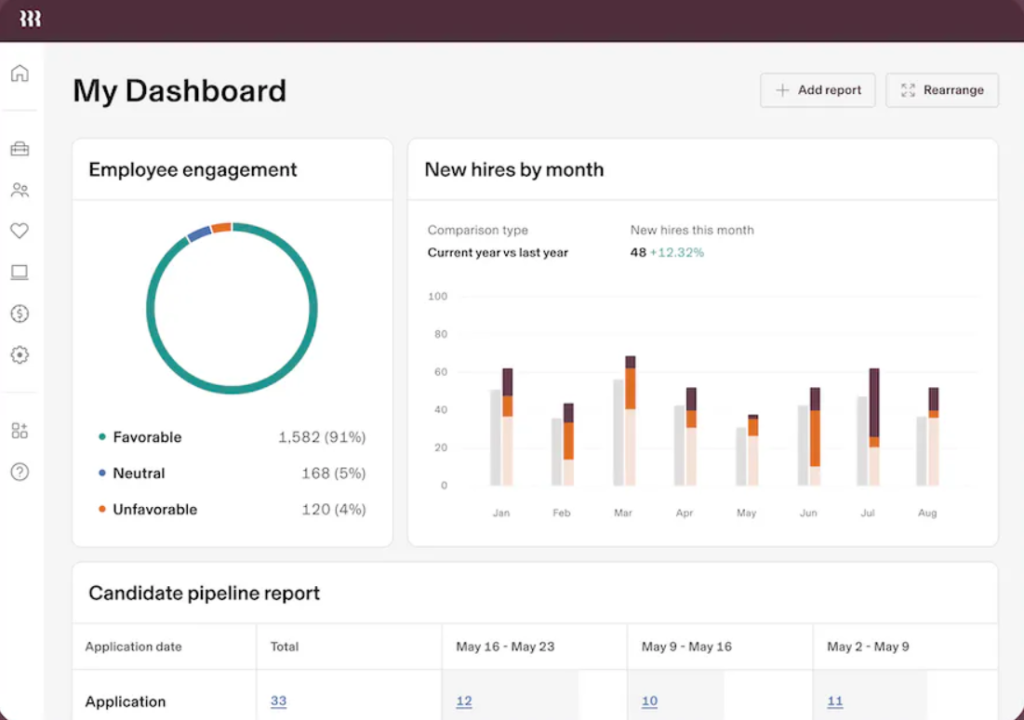
I once helped a growing e-commerce company that spent hours manually onboarding each employee, creating email logins, provisioning tools, tracking devices, and collecting signed documents.
Enter Rippling.
On their very first new hire post-setup, the IT lead looked at me and said, “Wait, that’s it?” Rippling brings the kind of automation that feels like cheating—in a good way. It connects HR, payroll, and IT in one place. You can assign a laptop, generate offer letters, schedule training, and enroll benefits, all within five minutes.
Rippling is a force multiplier for small HR teams and a lifesaver for companies scaling fast. It’s also modular, so you only pay for what you use.
Why Rippling Is One of the Best BambooHR Alternatives
- Device provisioning, software access, and app deactivation can all be managed inside Rippling. In contrast, BambooHR offers no support for IT or hardware management.
- Rippling offers international payroll and contractor support, while BambooHR is U.S.-only and cannot handle global tax compliance.
- You can build complex, automated workflows based on conditional logic—such as “If manager is in California, assign these onboarding steps,”—a level of customization that BambooHR does not support.
- Rippling’s native integrations cover over 500 third-party tools, from Google Workspace to Salesforce. BambooHR supports a much smaller set of integrations with limited triggers or syncing.
- Benefits enrollment, device orders, and training assignments can all be bundled into a single automated onboarding task list. BambooHR treats these as separate, mostly manual actions.
- Modular pricing means you can use Rippling just for payroll, just for IT, or all-in-one. BambooHR bundles features often require you to buy full packages regardless of need.
- The ability to manage both people and technology through one dashboard in Rippling gives operations teams a huge efficiency edge. BambooHR focuses strictly on HR and does not extend into IT or finance workflows.
Price: Custom pricing.
6. Gusto
Best for Payroll & Compliance Support
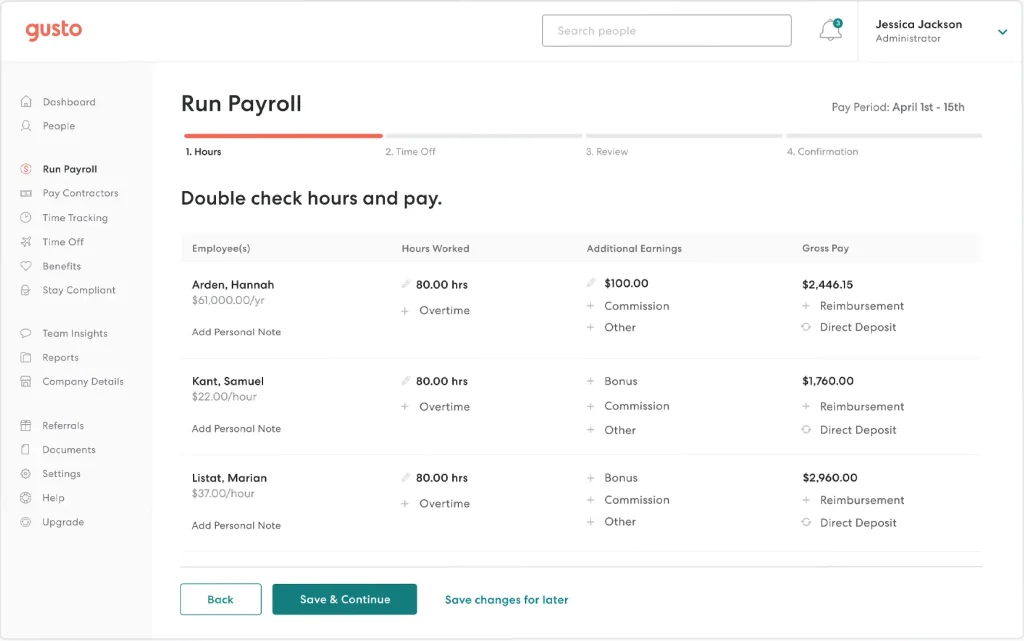
(Image Source: Software Advice)
A few years ago, I worked with a five-location bakery chain that was manually filing payroll taxes in multiple states and was always a week behind. They were already using Gusto, but somehow, did not run it the way it should be. I prepared a plan on how to run the tool for them, and within a week, the payroll ran on time, tax filings were automatic, and new hires enrolled in benefits without HR lifting a finger.
One of the co-owners said, “It’s like we hired a payroll manager who never complains and never makes mistakes.”
That’s what Gusto brings—relief. It’s made for small business owners who don’t want to become compliance experts. The platform is simple, yet powerful, covering everything from onboarding and PTO tracking to 401(k) setup and contractor payments. If you’ve ever dreaded tax season or benefits renewals, Gusto turns that dread into done.
Why Gusto Is One of the Best BambooHR Alternatives
- Gusto automates payroll tax filings across all U.S. states, including local, state, and federal compliance. BambooHR offers payroll services but requires more manual oversight and doesn’t match Gusto’s automation depth.
- You can enroll employees in health insurance and benefits directly within Gusto, and the platform acts as a licensed broker. BambooHR tracks benefits info but does not manage enrollment or broker services.
- Compliance documents such as new hire reports, W-2s, and 1099s are filed automatically in Gusto. In contrast, BambooHR requires integration with third-party tools or manual submissions.
- Hourly employees, salaried staff, and contractors can all be paid in the same run in Gusto, whereas BambooHR’s payroll is less optimized for flexible workforce types.
- Transparent pricing and plan-based billing make it easy for small businesses to budget. BambooHR requires a custom quote and tends to bundle advanced features into pricier tiers.
- Employees can self-manage tax forms, benefits enrollment, and direct deposit setup through Gusto’s modern portal. BambooHR’s self-service experience is more limited and less intuitive.
- The system is built for non-HR professionals, with intuitive dashboards, step-by-step task lists, and built-in reminders. BambooHR assumes a more traditional HR user base with more training required.
Price: Starts at $49/month + $6/user/month.
7. Zenefits (TriNet Zenefits)
Best for Administration & Compliance Support for SMBs

During a particularly chaotic benefits season, an HR manager once vented to me: “I have two monitors, six spreadsheets, and zero idea who’s enrolled in dental.”
They wanted a tool that could bring everything together. So I suggested Zenefits.
Within a month, her open enrollment process went from “please make it stop” to “I’ve got time for lunch again.” Zenefits doesn’t just digitize benefits—it connects the dots across payroll, compliance, and onboarding, so you stop duplicating work across five platforms.
Employees can review options and self-enroll, while HR automates eligibility tracking and deductions. I’ve seen teams set it up so that a new hire signs their offer, enrolls in benefits, and syncs payroll—without anyone in HR touching a form.
It’s built for the real world, where HR professionals have limited time, complicated regulations, and at least one employee who will lose their insurance card once a quarter.
Why Zenefits Is One of the Best BambooHR Alternatives
- With Zenefits, employees walk through a guided benefits enrollment process that includes plan comparisons and coverage breakdowns, which makes it much easier for them to self-manage. BambooHR, by contrast, offers benefits tracking but doesn’t include employee-facing tools to handle enrollment or plan selection.
- The platform automatically handles ACA compliance, like tracking full-time equivalency and generating 1095 forms. BambooHR does not include ACA-specific tools, often leading to added complexity for U.S.-based SMBs.
- Payroll deductions are instantly updated based on the employee’s chosen benefits in Zenefits, preventing manual errors. BambooHR users must often reconcile benefit selections separately from payroll, introducing potential for mismatches.
- Zenefits sends alerts for compliance deadlines and overdue documents, so nothing gets lost in email purgatory. BambooHR has reminders but lacks Zenefits’ built-in compliance automation logic.
- HR teams can create onboarding workflows that incorporate benefits enrollment and tax documentation in one seamless sequence. In BambooHR, these tasks typically live in separate parts of the platform.
- On premium plans, Zenefits includes access to certified HR advisors, so you can get real answers to tricky labor law questions. BambooHR doesn’t offer this level of in-platform guidance.
- Zenefits follows modular pricing, allowing small teams to activate only what they need. With BambooHR, pricing is less flexible and often requires bundling features that may not apply to every team.
Price: Custom pricing.
8. HiBob (Bob)
Best for Customizing Onboarding Flows
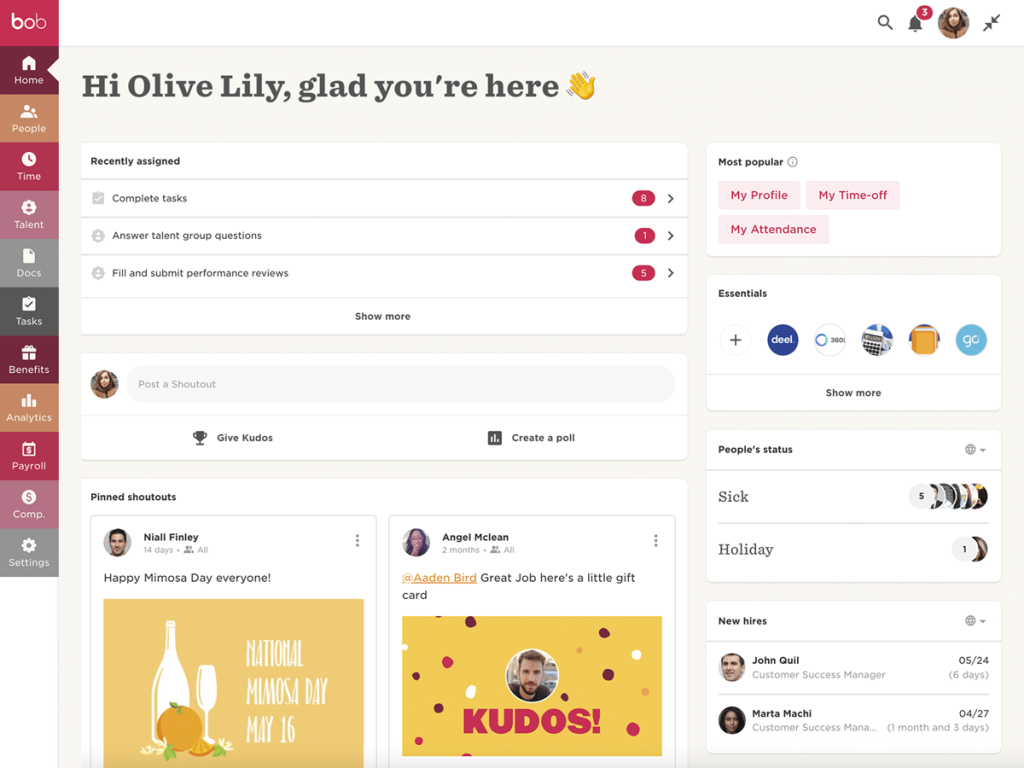
In one of our internal rollouts, a manager in Berlin flagged that his team had no idea what holidays their U.S. colleagues celebrated—and vice versa. HiBob fixed that in less than a week.
We built regional PTO policies and added cultural fields to profiles. Suddenly, employees started saying things like “Merry Christmas!” and meaning it. That’s HiBob’s strength—it lets you run serious HR operations across multiple regions without turning everything into a compliance checklist.
You can launch localized onboarding flows, automate employment contracts based on country, and give employees profile pages that make them feel like more than a payroll ID. For companies that care about how people work together, especially across time zones and cultures, HiBob keeps your global team aligned, informed, and a little more human.
Why HiBob Is One of the Best BambooHR Alternatives
- HiBob allows admins to set time-off rules, holiday calendars, and employment policies by country or region, which is crucial for global compliance. BambooHR, however, assumes a more U.S.-centric model and offers limited localization features for international use.
- Employee profiles in HiBob are built to reflect culture and personality, hobbies, languages, pronouns, and even work style preferences, making collaboration smoother. BambooHR focuses primarily on core employment data and doesn’t offer this level of employee personalization.
- With the social feed, team members can recognize peers, share milestones, and keep in touch across offices, encouraging informal connections. BambooHR doesn’t have built-in tools for recognition or culture-building across distributed teams.
- You can create region-specific onboarding workflows that include compliance documents, welcome messages, and team introductions. BambooHR provides a general onboarding checklist that’s consistent across all roles and locations, with fewer personalization options.
- HiBob enables you to collect real-time feedback with pulse surveys and track sentiment across different groups. BambooHR includes basic surveys like eNPS but lacks granular reporting or cultural insights.
- The analytics dashboards in HiBob surface trends in engagement, attrition, and DEI representation across global teams. BambooHR offers functional HR reporting but doesn’t provide advanced cross-cultural analysis.
- Workflow automations in HiBob allow you to tailor actions based on department, region, or tenure—such as sending a different onboarding email to a contractor in Germany than a manager in Texas. BambooHR automations are more linear and apply universally without this level of specificity.
Price: Custom pricing.
9. ADP Workforce Now
Best for Employee Attendance Management
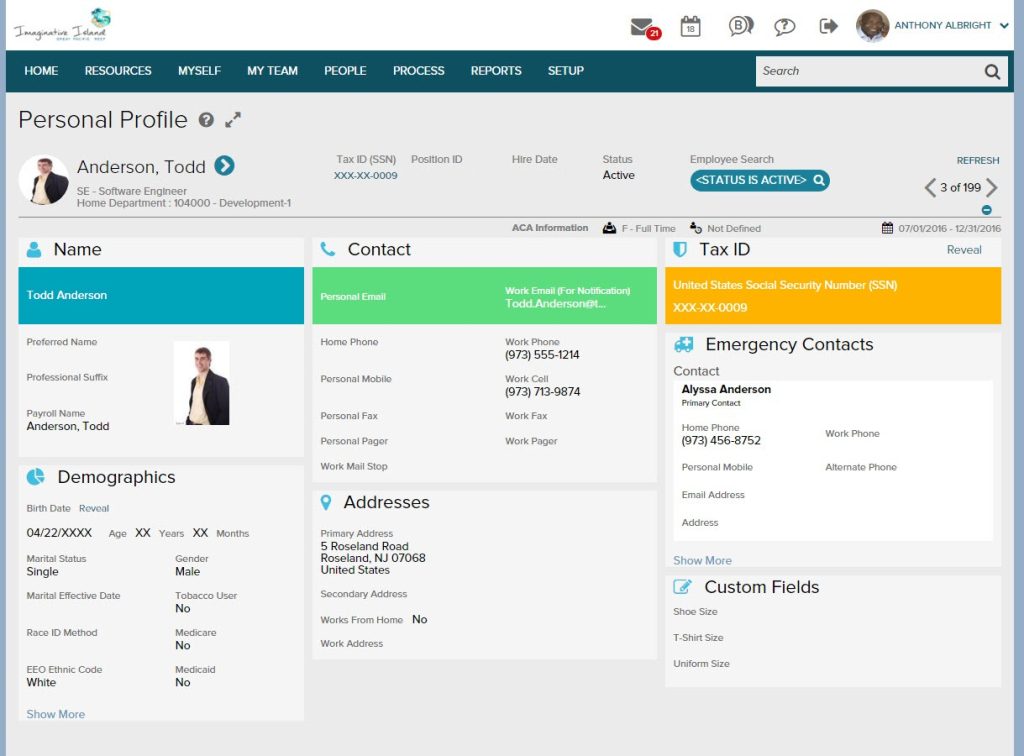
At a 700-person client I supported, the payroll lead once told me, “If someone misfiles a tax form again, I’m going to take early retirement.”
That’s when we knew it was time to graduate from a lightweight system to something more enterprise-ready. ADP Workforce Now brought the relief they needed—automated payroll, multi-state compliance, and enough audit trails to make an auditor smile.
It’s not built for flair, it’s built for reliability. Whether it’s configuring complex permissions, syncing directly with benefit carriers, or preparing for a Department of Labor audit, ADP lets your team get ahead of the chaos.
And if you have offices in multiple states or plans to scale fast, this platform helps you stay compliant, consistent, and calm under pressure.
Why ADP Workforce Now Is One of the Best BambooHR Alternatives
- ADP processes payroll across all 50 states with real-time tax compliance updates and automatic filings. BambooHR, while offering payroll, has more limited multi-state handling and may require manual oversight for more complex organizations.
- The platform connects directly with benefit carriers, meaning eligibility changes and enrollments sync without extra uploads. BambooHR users must manually update benefits and rely on external tools to handle carrier communication.
- ADP includes built-in OSHA, EEO-1, and ACA reporting modules, which are critical for regulated industries. BambooHR does not offer built-in government compliance modules and requires users to export and format data manually.
- You can assign granular permissions by location, department, or role—critical when your workforce spans multiple states or units. BambooHR supports basic role-based access but isn’t designed for complex hierarchies.
- Workforce analytics in ADP helps predict turnover, model compensation changes, and highlight regulatory risks. BambooHR reporting is more focused on standard metrics like time off, headcount, and performance completion rates.
- Onboarding in ADP includes tax form automation, electronic verification, and even WOTC credit tracking. BambooHR has onboarding checklists and document collection, but doesn’t support government incentive programs.
- Enterprise teams benefit from dedicated implementation managers and compliance support through ADP, while BambooHR’s service model is more standardized and geared toward small to mid-sized clients.
Price: Custom pricing.
10. Paylocity
Best for Online Payroll Solutions
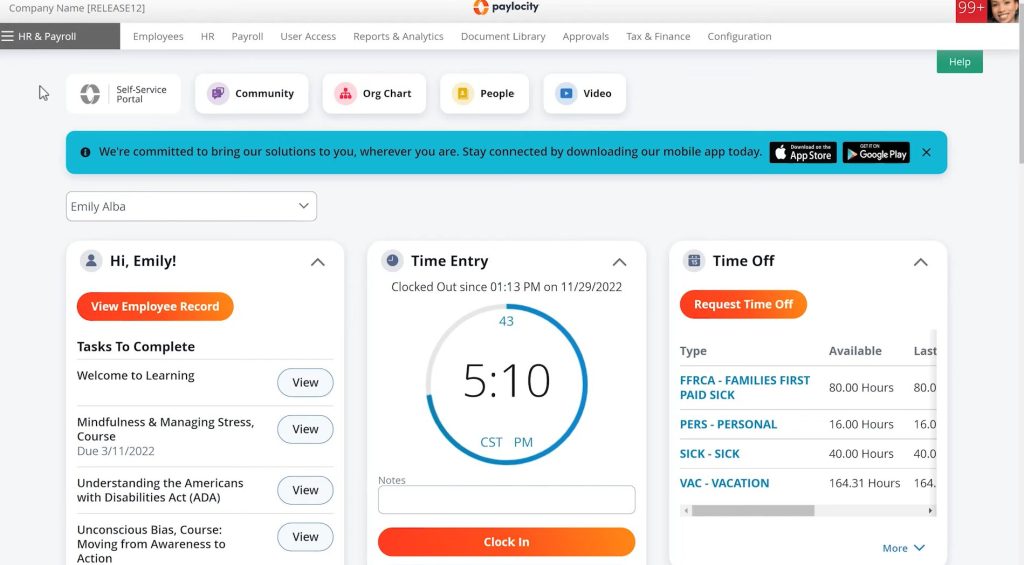
If you’re like me and have supported teams caught between spreadsheets, clunky payroll add-ons, and a separate survey tool no one logs into, Paylocity feels like a relief. It gives you everything you’d expect from a modern HR platform, like payroll, onboarding, time tracking, benefits, and performance, but adds something most platforms miss: built-in employee engagement.
You can create video announcements, recognize peers in a social feed, and launch anonymous surveys that actually lead to action. Your managers won’t need to guess who’s disengaged or burning out—they’ll see the trends clearly. And as an admin, you’ll finally stop toggling between five systems just to answer a PTO or turnover question.
If you’re looking for a platform that lets you run operations and keep people connected—all in one place—Paylocity does that without the extra complexity.
11. Skima AI
Best for Faster and Precise Candidate Screening

A recruitment firm I worked with struggled to find quality candidates quickly. Their applicant tracking system had a good database, but it lacked intelligence. When they switched to Skima AI, everything changed. Recruiters could rapidly identify the right talent from thousands of resumes. They rediscovered top candidates hidden in old pipelines. They also launched tailored outreach campaigns within minutes.
I’ve seen Skima AI in action; it’s like adding an intelligent co-pilot to your recruiting stack. One recruiter told me, “It feels like ChatGPT for hiring, only it actually understands resumes.” That’s what makes Skima different: it doesn’t just organize data, it interprets it.
With AI-driven sourcing, skill-based matching, and smart campaign automation, Skima brings order to recruiting chaos. It’s not just another ATS; it’s an AI layer that makes your existing tools smarter, faster, and much more efficient.
Why Skima AI Is One of the Best BambooHR Alternatives
- BambooHR’s applicant tracking relies mostly on basic keyword filtering, which often overlooks qualified candidates. Skima AI uses contextual, AI-driven matching that analyzes skills, experience, and evidence to surface the most relevant profiles instantly.
- BambooHR’s resume parsing is limited to simple data extraction. Skima AI offers deep parsing that identifies skills, experience levels, and even quantifiable achievements for precise candidate assessment.
- Once candidates are archived in BambooHR, they’re rarely re-engaged or surfaced for new roles. Skima AI’s rediscovery engine automatically mines past applicants and highlights those who best fit current openings.
- BambooHR doesn’t provide built-in personalized outreach or engagement automation. Skima AI allows recruiters to run AI-personalized outreach campaigns at scale, boosting response rates and candidate experience.
- BambooHR offers limited flexibility in customizing hiring pipelines and workflows. Skima AI lets teams design dynamic recruiting workflows tailored to role types, stages, and recruiter preferences.
Price: Free 14-day trial. Paid starts at $49/seat/month.
Why Paylocity Is One of the Best BambooHR Alternatives
- Paylocity offers real-time engagement tools, including video announcements, kudos posts, and an internal social feed—all within the platform. BambooHR has no native social or recognition tools built into the interface.
- Time tracking, scheduling, and labor cost forecasting are part of the same system, allowing teams to plan workforce needs and budget more effectively. BambooHR’s time tracking is solid, but it doesn’t extend to forecasting or shift planning.
- The onboarding experience in Paylocity supports videos, interactive content, and dynamic task routing, making it feel personalized for each role. BambooHR uses static checklists, which are functional but less engaging.
- Performance reviews in Paylocity include multi-rater feedback, goal alignment, and development tracking. BambooHR reviews are more linear and tied mostly to manager evaluations without peer or self-review integration.
- You can launch anonymous engagement surveys with trend dashboards that link feedback to action items for managers. BambooHR offers basic surveys but doesn’t provide structured follow-through or analytics.
- You can even integrate and assign learning content post-review, helping reinforce development conversations. BambooHR doesn’t support LMS integration or internal training delivery.
- Reporting dashboards in Paylocity pull together data from payroll, engagement, and performance to show cross-functional trends. BambooHR dashboards are segmented by feature and don’t combine insights across the employee lifecycle.
Price: Custom pricing.
How I Collected These BambooHR Alternatives/My Evaluation Criteria
You’re probably wondering how I picked these 11 BambooHR alternatives from the sea of HR software out there.
Well, I didn’t just scan a few listicles and call it a day. I’ve either used these platforms directly, helped clients implement them, or seen them win (and sometimes lose) in real-world HR environments.
Here’s the exact framework I followed to evaluate each alternative to BambooHR—so you can trust the recommendations match your needs:
1. Real User Ratings & Feedback
Before shortlisting any tool, I dug into actual user reviews on G2, Capterra, TrustRadius, and Reddit. I wanted to hear what day-to-day users were saying—what works, what breaks, and what made them switch. That ground-level insight helped me filter marketing hype from true performance.
2. Features That Actually Solve Problems
I didn’t just list out flashy features. I looked at whether each tool solves common gaps in BambooHR, like a lack of multi-rater feedback, limited OKRs, or rigid workflows. You’ll find these tools bring something valuable to the table, whether it’s automated onboarding in Rippling or continuous development in Lattice.
3. Usability in the Real World
I paid close attention to how intuitive each system felt when I used it or when clients rolled it out. If a platform required a user manual thicker than your employee handbook, it didn’t make the cut. Tools like 15Five and Gusto made it to the list because managers and employees actually used them, without extra hand-holding.
4. Support That Doesn’t Leave You Hanging
Whether you’re setting up custom workflows in PeopleGoal or configuring payroll in Gusto, support matters. I looked at how fast support teams respond, the quality of onboarding help, and whether you get real humans or just chatbot loops when things go wrong.
5. Pricing Transparency & Value for Money
I favored platforms that are upfront about what you’ll pay, and give you enough flexibility to pay only for what you use. Modular pricing (like in Rippling or Zenefits) scored higher than bundled packages that force you to buy features you’ll never need.
6. My Firsthand Experience & Expert Opinions
This article isn’t just theoretical—I’ve consulted for companies using these tools, helped run rollouts, and interviewed HR teams about what worked and what flopped. That context helped me go beyond surface-level claims and show you how each platform behaves in the real world.
What Are the Best BambooHR Alternatives?
Finding the right HR software comes down to what works best for your team, not just today, but as you grow. Maybe you need deeper performance tools, easier payroll, or better ways to engage people.
Whatever the gap, there are solid BambooHR alternatives out there to fill it. I’ve worked with many of these tools in different company setups, and each one has its strengths.
If you’re asking me for a personal favorite, I’d go with PeopleGoal. The customizable interface and built-in App Store let you shape the system around your workflow, not force your team to adjust to it.
Which one of these tools did you find the best?
Frequently Asked Questions
2. Why are teams moving away from BambooHR?
Many teams outgrow BambooHR when they need more control over workflows, deeper analytics, or stronger performance management. Others look elsewhere because of the additional payroll or performance module costs or limited international support. It’s common for companies scaling beyond 100 employees or managing distributed teams to seek a platform that’s more flexible and insight-driven.
3. Which BambooHR alternatives are better for performance reviews and employee development?
If performance is a priority, platforms like PeopleGoal and 15Five are often a better fit. These tools offer features like continuous feedback, 360-degree reviews, goal tracking (OKRs), and employee development plans, all of which are either limited or unavailable in BambooHR. They’re built for companies that treat performance management as an ongoing process, not a once-a-year formality.
4. Are any alternatives more affordable or transparent in pricing than BambooHR?
Absolutely. Tools like PeopleGoal and Gusto offer upfront, per-user pricing with no hidden module costs. BambooHR often requires a sales call to unlock pricing, and many features, like performance reviews or payroll, are sold separately. If predictable costs and modular pricing matter to you, there are more budget-friendly and transparent options on the market.
Ready to 3x Your Teams' Performance?
Use the best performance management software to align goals, track progress, and boost employee engagement.

